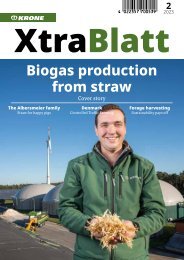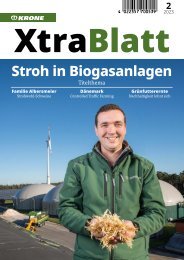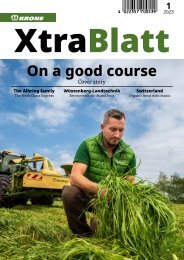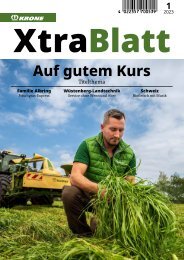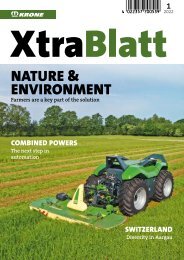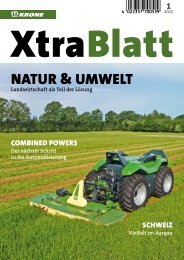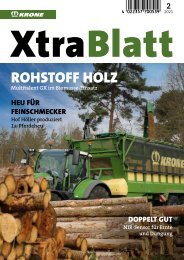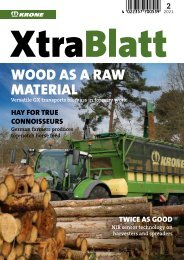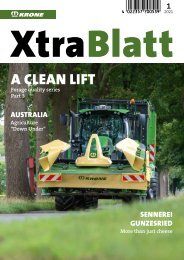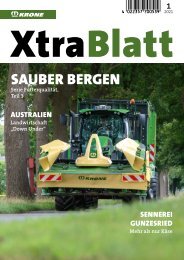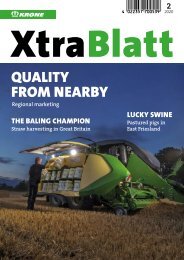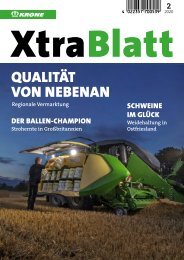XtraBlatt Issue 02-2017
Create successful ePaper yourself
Turn your PDF publications into a flip-book with our unique Google optimized e-Paper software.
It’s almost all in the family on this<br />
farm with (from l.) the future sonin-law<br />
Jonathan Brossler Gérard,<br />
Laurence, Noémie and Arnaud Cassin.<br />
The Cassin family dairy farm lies in<br />
northwest France, more precisely in<br />
Coron some 80 km east of Nantes. On our<br />
arrival, a few cows stood in pens around<br />
the farmhouse, a bitch with three whelps<br />
lay at the door. With its light colour and<br />
low form, the house had a maritime look<br />
about it. Direct on the farm road are the<br />
barns for milk cows and calves. Alongside,<br />
some tractors stand with cultivation implements.<br />
That’s the first impression. This farm has<br />
been in family hands since 1968 with the<br />
two children Noémie and Arnaud taking<br />
over as managers in 2013. Around 170 ha<br />
are farmed. This includes 55 ha maize, 25<br />
ha grass seed multiplication crops and 45<br />
to 50 ha cereals, mainly barley. “The soil is<br />
actually not especially suitable for grain,”<br />
explains Arnaud Cassin. Maximum grain<br />
harvest is 7.5 t/ha. With forage maize the<br />
dry matter yield is around 10 to 15 t/ha.<br />
The quality fluctuates so much that the<br />
cereal grains are usually all used for feed.<br />
The rest of the farm area comprises pasture.<br />
In part, grass is sometimes sown as<br />
catch crop on the arable land.<br />
FORAGE HARVEST<br />
An agricultural contractor undertakes<br />
the maize and cereal harvests while mowing<br />
and carting home a portion of the<br />
forage is for the most part a family affair.<br />
With three tractors from New Holland<br />
and Deutz-Fahr, a Deutz-Fahr telescopic<br />
loader and a Krone round baler, the grass<br />
harvest can be left to the family. Around<br />
900 bales of grass silage are usually made<br />
with an average 100 bales of hay and<br />
900 of straw. The remaining machinery<br />
for all the work: e.g. further round balers,<br />
one with cutterhead, an eight-rotor<br />
turner from Krone, a Monosem drill, tipping<br />
trailer and slurry tanker from Jeantil<br />
have been bought by the family with the<br />
help of a purchasing syndicate (Cuma in<br />
French) over the dealership Service Agri.<br />
Four neighbouring farms are involved in<br />
this Cuma. Some of these machines are<br />
already over 10 years old. The Cuma also<br />
offers equipment for tube silage. On the<br />
other hand, biogas production plays no<br />
role in this region. “Our slurry is all spread<br />
on our fields. At a distance of 15 km, the<br />
nearest biogas plant is too far for us,”<br />
says Arnaud Cassin.<br />
Normally, silage grass is mowed twice. If<br />
the weather allows, a third cut is possible.<br />
“However, we prefer to graze the areas<br />
then. The quality of the grass is not good<br />
enough,” explains father Gérard Cassin.<br />
Feed legumes such as lucerne don’t play<br />
any role on the Cassin farm. “The soil here<br />
is too acid and too dry,” says the senior boss.<br />
Irrigation is too dear to consider, he adds.<br />
“We are completely dependent on rain. This<br />
year it was very dry, and we certainly notice<br />
that,” explains mother Laurence Cassin. Because<br />
of the mild temperatures the whole<br />
year, the family has no problems with frost,<br />
e.g. frozen water pipes. “Seldom do temperatures<br />
sink below -5°C,” she adds.<br />
35



